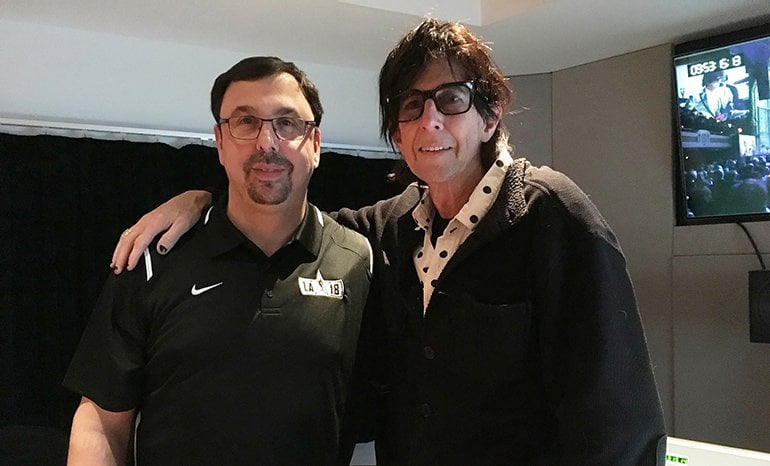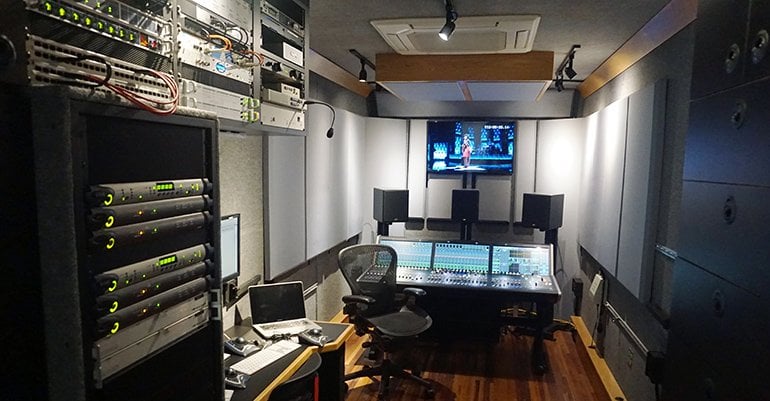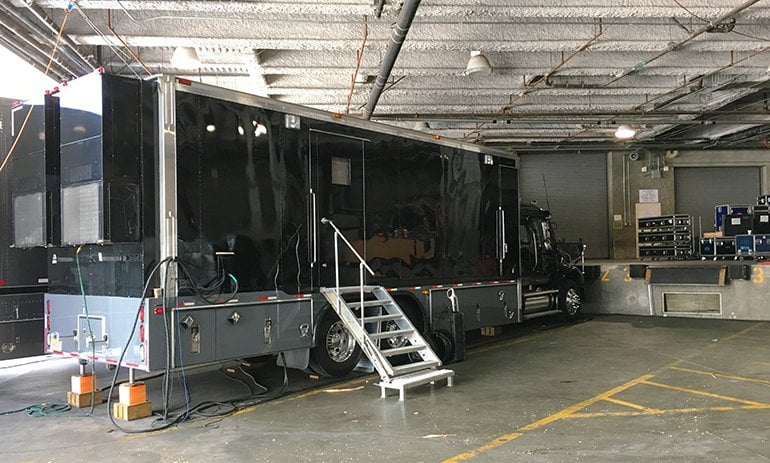In 2008, longtime colleagues Joel Singer, John Harris, Mitch Maketansky, and Jay Vicari founded Music Mix Mobile with a goal to provide state-of-the-art remote recording and live broadcast services. One half of the team spun out of Effanel Music, which offered live broadcast, recording, and post-production for large-scale concerts and television events from 1980 until the company was acquired by XM Satellite Radio (now SiriusXM) in 2005.
These days, M3 is a bicoastal operation, sending two big rigs and award-winning team of nine engineers around the country for events ranging from the Grammy Awards to concerts by U2 and the Foo Fighters. I caught up with M3 cofounder/co-owner Joel Singer in late March as he was preparing for the 2019 Rock and Roll Hall of Fame Induction Ceremony to find out how the mobile recording and broadcast business has evolved in the past decade.
Sarah Jones: I hear you’ve had a pretty busy first quarter.
Joel Singer: January was a really busy month for us. We did a couple of shows around the Super Bowl, Foo Fighters, and the NFL kickoff. And, of course, the Grammys. We went straight from that to the NBA All-Star Game [halftime show], and then the iHeart Radio Music Awards.
SJ: You seem to cover sports events pretty regularly.
JS: We do things surrounding sports events, but not the sports themselves. And rarely the music within sports broadcasts, with the exception of the NBA All-Star Game. Because much of it is planned and sometimes not as live as you’d like it to be: The need for a large scale music truck is not necessary. The NBA All-Star Game does larger scale live acts, which is why we are involved with them. We're doing work around the NCAA Final Four this year, also.
We’re constantly tweaking the model a little bit here, a little there. Right now broadcast for music is non-evolving. Surround has been here for such a while, but not totally accepted by acts for live broadcast. ATMOS is a buzz word that keeps popping up but we haven’t been asked to provide that service for any broadcast, even though we’re quite capable with our Lawo systems.
SJ: How does that translate to the rigs? Do you send out more flight packs, for example?
JS: It’s the same stuff. We have our flight pack systems, and they go out regularly at the same frequency they did last year. And, we have our trucks, and they go out regularly. So it hasn't really affected us in the equipment part of things at all.
Other than that, we changed over from Avid surfaces/mixing systems to Lawo in all of the trucks. And, I'm very happy about that. We still record on Pro Tools. We're the only recording entity in the entire country that records on dual Pro Tools rigs for a master and a safety. We've also added some hardware consoles to the flight packs. We bought a Soundcraft Vi2000 to put into our 96-channel flight pack so that we can do a bit more with that.

SJ: How much are you called on for specific technologies?
JS: The way M3 was built in the beginning was that John Harris and I came from the idea, “always do it one way, and that's the right way.” That's why when I joined Effanel, they were enamored with what I had built in a small truck. It had the first DM2000 in the country, and digital DTRS machines and hard-disk recorders. I was also the first to use the remote-controlled Aphex 1788 preamps. At that point, in 2003, that was state-of-the-art stuff, and I was doing it in a small, 18-foot truck in a more cost-effective way than anyone could do. And, when we joined forces, it just became the idea that if you have the people, trust the engineers. Clients would trust whatever we chose as gear.
SJ: Do you feel a pressure to respond to evolving technologies, like Dante or AVB, those kinds of protocols?
JS: No, we don't. We trust technology, and we choose what we want to use. And, we know that we have to adapt here and there for people coming in and saying, "Can you interface to us?" And so on. We go with the technology that we trust the most and that makes the most sense for us. We're not driven by “everyone's going Dante, and you have to go Dante, or else you're going to be behind the curve;” it just doesn't make sense to us.
We know that that at some point we will be on an IP protocol, and we will be transporting data that way. We have some Dante devices. But, we've chosen the Ravenna path that Lawo uses. And, even though right now we're still just utilizing MADI as a path for everything, at some point in the future, we will change over to Ravenna, and start building more of a Ravenna topology in our system.
That's why we chose Lawo, because they were on their way toward all of that. And, it made sense to me as a technical person to pick the company that was going to have the strength in that, but also have the outward ability to be more in common with the rest of the world rather than closing ourselves off to a manufacturer or a chip provider.

SJ: You just bought a bunch of Universal Audio Live Racks. Are these an extension of your experience with UA in the studio?
JS: We've used UAD for years, whether it's been in the cards or the satellite, or whatever in the studio. People say, "What's better? Waves or UAD?" And, I keep saying that they're just totally two different beasts. If you want the greatest of all worlds in broadcast, have both of them, like we do. And they both coexist so well that you have this great ability to really mold whatever you need in whatever application to fit without having to have a rack of 25 pieces of gear sitting behind you.
SJ: Is gear weight even a consideration at this scale?
JS: Not anymore. Our trucks are so light. Back in the day, we used to have to worry about weight. But nowadays, the big truck is registered at 55,000 pounds. I think if we have 37,000 pounds in it; it's a lot. But, there are no more big analog tape machines and consoles that weigh thousands of pounds.
SJ: What are some of the ways that you're using Live Rack?
JS: We just finished doing a couple of shows. And, the Live Racks were used for certain emulations, like the AMS Reverb has classic nonlinear program that everyone uses on drums. It's just spot on. The Distressor program is a spot-on emulation of the Distressor. It's perfect. We've used the EMT plates, like the 140 and the 250. You can't carry a plate with you on the truck; it just doesn't work. But, having the emulation of it is great.
The Live Rack has low, low latency...before, we were pulling an Apollo 16 into situations when we needed a UAD. You'd go in and out of an analog as an insert. Because the Apollo 16 processes everything in the box itself, you were able to get the low latency in the Apollo 16 also. But, it didn't offer any of the recallable parameters that the Live Rack does.
You can setup presets where you can have 16 inserts on a standard Live Rack. You can have 16 different plug-ins for this scene. You hit the Recall button and those plug-ins can change into 16 new plug-ins and 16 new settings.

It's so flexible that it makes it good for a broadcast show like the Grammys where you have 18 different acts. So, you're not going to be using the same stuff. And, it's cool that you can really have the flexibility of whatever you want to do within the box. You can chain plug-ins; you can do a number of different things. It used to be a dance in-between acts. Now, you can do a changeover where you have all the presets recalled right then and there.
It’s a wonderful ability to have engineers from different artists who are used to plug-ins from both Waves and UAD accept their use in live broadcast. It makes them feel more comfortable to use the same software they use to record and mix their artists.
SJ: Having that kind of flexibility, especially for a show like the Grammys, do you find that you're spending more time at a micro level? How does your workflow change now that you have this freedom?
JS: It absolutely gives you more time to spend on a micro level. Some of the shows really come to life that way, because you can take that time instead of having to break down and then reset and take an entire 20 minutes to start working on something new again.
SJ: How do you keep things future proof?
JS: As the systems change, we get more flexibility. As all these systems keep moving forward, we don't have to reinvest the amount of money that we used to in the old days. And, we can get more return on our investment.
Sarah Jones is a writer, editor, and content producer with more than 20 years' experience in pro audio, including as editor-in-chief of three leading audio magazines: Mix, EQ, and Electronic Musician. She is a lifelong musician and committed to arts advocacy and learning, including acting as education chair of the San Francisco chapter of the Recording Academy, where she helps develop event programming that cultivates the careers of Bay Area music makers.